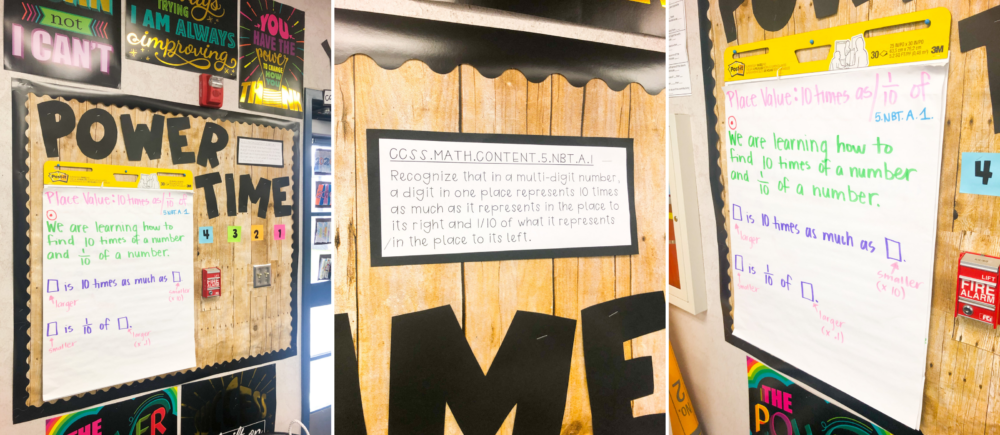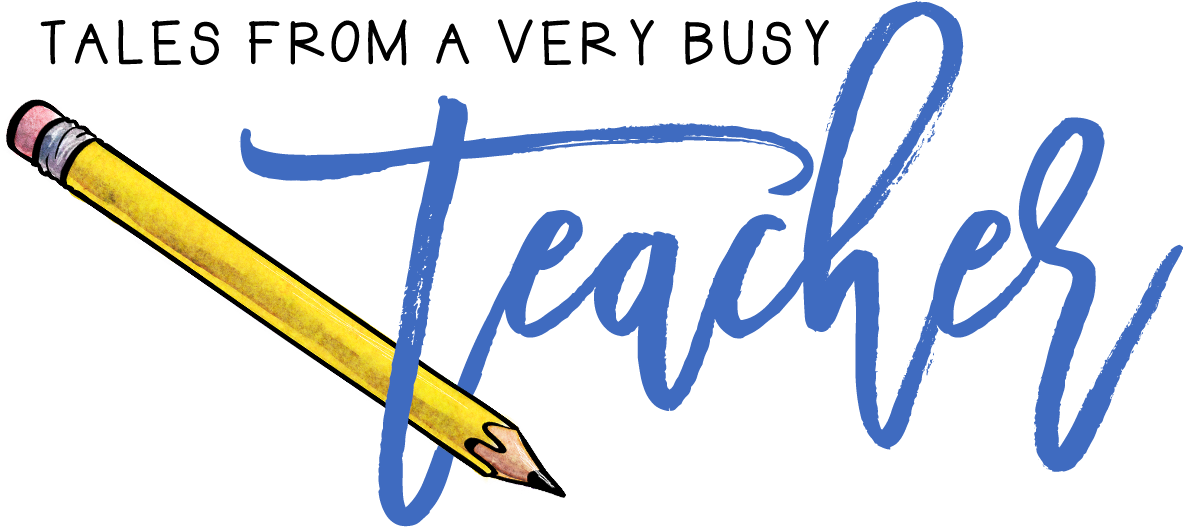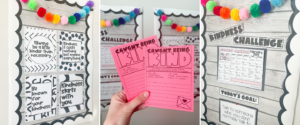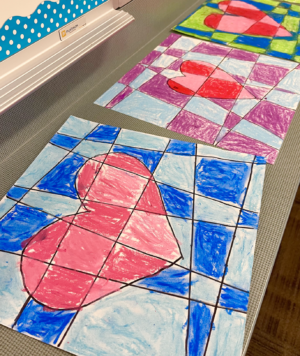Our time with our students is valuable and we need to be intentional when we think about our schedule, lesson plans, and intervention goals.
Once districts and schools shift their focus to intentionality and purpose, progress is made.
One area of focus that can produce higher student achievement and increase student participation in learning is through planning targeted intervention blocks with intention.
This always works best when you work with your grade level team, share collective efficacy, and if you believe ALL students can learn and improve. This will also be effective if you dedicate a specific time of the day, every day, to target interventions.
If you don’t already have something in place, start with one content area.
When we started our intervention journey in my California school (where I taught third and fifth grade for 10 years), we chose to begin with math and called our intervention time “Power Time.” Immediately after recess, we dedicated 30 minutes to math intervention. We were intentional and explicit in what we wanted our students to do while we worked with our small groups, and we were specific with our learning targets, data tracking, and future planning.
Here’s how it worked:
Essential Standards
We started with our district’s essential standards. These can also be called priority standards. Essential standards represent “the minimum a student must learn to reach high levels of learning.” They also serve as the focus for assessing student learning and implementing interventions when our students do not learn. It’s all about focus. Prioritizing the standards and identifying those essential/priority standards is done as a collaborative team (DuFour et al. 2016).
Larry Ainsworth has a process to guide educators in establishing their essential/priority standards:
- Does the standard have endurance? Are students expected to retain the knowledge and skill beyond the unit?
- Does the standard have leverage? Will the student be able to apply the standard in more than one subject area?
- Does the standard prepare the students for success at the next level? Has this standard been identified as an essential prerequisite skill in the next course or grade level?
- Will the standard prepare students for success on high-stakes external exams? Is this a concept or skill that students are most likely to encounter on state exams, college entrance exams, or occupational competency exams?
I’ll be writing a separate blog post on this in more detail, but you can find more about this in Learning by Doing. Click here to find it on Amazon (aff link) and check out the section that’s titled “Prioritizing the Standards.”
I also have a list of essential standards based on the California State Standards here. This is what my grade level team and I came up with when we worked on this task, so they were created based on our school’s needs. They may not be the same for you and your school, but they’re a good starting point.
Create Learning Goals and Success Criteria
Once your essential standards are determined, you and your team will need to make these into learning goals and success criteria. I detail how to make standards into learning goals in my book, Getting Started with Teacher Clarity (which you can find on Amazon-aff link). But here is quick example based on one of the essential standards outlined above:
CCSS.MATH.CONTENT.5.OA.A.1
Use parentheses, brackets, or braces in numerical expressions, and evaluate expressions with these symbols.
- We are learning how to use parentheses, brackets, or braces in numerical expressions.
- We are learning how to evaluate expressions using parentheses, brackets, or braces.
- We are learning how to use the order of operations to evaluate expressions.
- We are learning how to use the order of operations in numerical expressions.
Pace Your Lessons
My team and I always found it most effective if what we were teaching in our intervention groups lined up with what we were teaching in our core instruction. With that in mind, we lined up our learning goals for intervention with our pacing guide. This helped us create targeted lessons at the right time so students would get double practice, in intervention time and core instruction time.
Track the Data
This was the most inspirational part, for our grade-level team and our students.
Let me show you how it worked with using this standard for fifth-grade math:
5th Grade Math Standard:
- OA.1 Use parentheses, brackets, or braces in numerical expressions, and evaluate expressions with these symbols.
Learning Goals:
- We are learning how to use parentheses, brackets, or braces in numerical expressions.
- We are learning how to evaluate expressions using parentheses, brackets, or braces.
- We are learning how to use the order of operations to evaluate expressions.
- We are learning how to use the order of operations in numerical expressions.
Success Criteria:
- I can write and evaluate expressions.
- I can use the four operations to evaluate expressions and solve word problems.
On the first day of this intervention cycle, I would give my entire class a pre-assessment based on the learning goal and standard. Some of my students may have background knowledge on this standard, especially since it’s an essential standard that was introduced in previous grade levels. I would have them rate their level of understanding and show as much as they know on this assessment. A great way to create these assessments is through the Common Formative Assessment process.
You can find more on that in Learning by Doing, and I’ll also dissect it further in a subsequent blog post. Great resources are also located in Smarter Balanced and their Interim Playlist Connection and Tools for Teachers. If your state contracts with Smarter Balanced, these are great resources to help you create your assessments.
After grading the pre-assessment I would place my students into their intervention groups. Depending on the size of your class, you can have 3-4 groups. Using the pre-assessment results, I would group my students accordingly. Students who need extra support would be in one group, students who need extension would be in another group, and students who are at grade-level would be in a third group. Your fourth group could be made up of your targeted intervention kiddos or your extension kiddos to help you break up the size of your groups so your learning time is more effective.
Our grade level typically ran an intervention cycle for 12 days, or 5 days if it’s a targeted intervention on one standard/skill.
Day 1: Pre-assess
Days 2 through 11: Meet with groups and teach
Day 12: Post-assessment
Tracking students’ growth between the pre and post-assessments was HUGE! It was also imperative to continue formative assessment throughout the intervention cycle. I would have students graph their own data for the pre-assessment. They would also keep all of their exit tickets throughout the intervention cycle and use those to reflect on their learning. They would then graph their score for the post-assessment and compare the growth between the two tests.
Giving students the power to track their own data and reflect on their learning was a huge motivator.
These four steps will help you frame your intervention time with intentionality and purpose. You can continue the cycle for each essential standard or any other skill your students need support with throughout your units. I also liked to have a bulletin board up of what we were focusing on for our intervention time. As I said, we called it “Power Time” and it was a great focal point in our classroom.
You can find pieces to the bulletin board here for FREE. I also included the numbers 4, 3, 2, and 1 on the board. I would ask students a closure question to assess their level of understanding and they write on the post-it note and place it under the number that represented their level of understanding on their way out the door.

Here are a couple more things to consider as you organize and structure your intervention groups with intention:
Targeted Skill or Group of Skills
You can also group a few standards together that will be in your unit for an intervention cycle. This type of instruction can go for a period of 9-12 school days. Try to only use no more than 2-3 standard/learning goals if you’re grouping them together.
You can shorten your intervention cycle to 5 days if you’re targeting a specific standard/skill with an intense and specific intervention.
Over Assessing
We don’t want to burn our students or ourselves out on assessments. Using a pre and post-assessment is helpful when tracking data and to encourage students to take ownership of their own learning. These should not be used for grades as they’re all formative assessments to help guide instruction and target our interventions.
If your school site uses additional (and unnecessary) assessments, try to “influence up” as Dr. Many suggests. Assume good intentions on the part of your administrators and also believe that adults (even principals) can learn.
Ask to set aside some time with your administrators so you can explain the importance of the intervention cycle and using assessments with intentionality. If you feel comfortable, offer to help your administrators in supporting the school’s effort to implement interventions with intention and purpose. Help them understand your thinking, your mission, and your ideas.
Independent Activities: What Your Other Students Are Doing
Click here to read more about what your students can be doing while you’re working with your small group of students during intervention.
Information for this blog post was compiled from Learning by Doing: DuFour, Richard, Rebecca DuFour, Robert Eaker, Thomas W. Many, and Mike Mattos. Learning by Doing: a Handbook for Professional Learning Communities at Work. Solution Tree Press, 2016.




